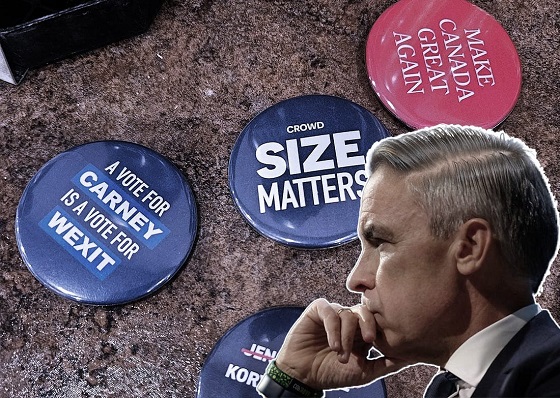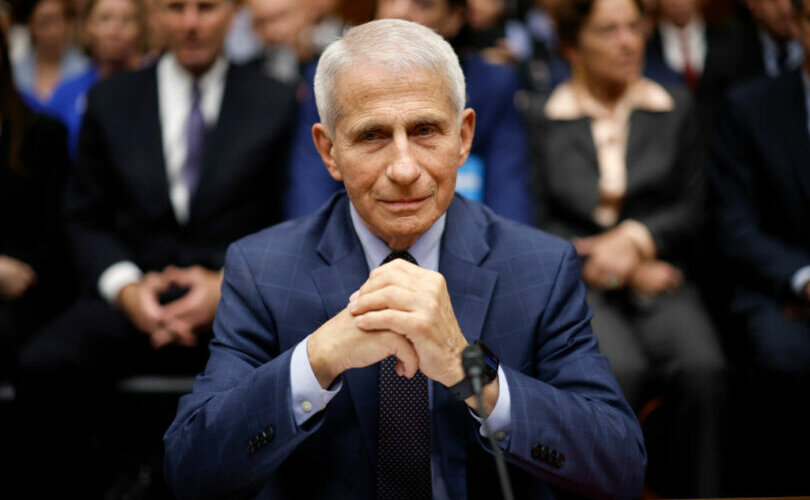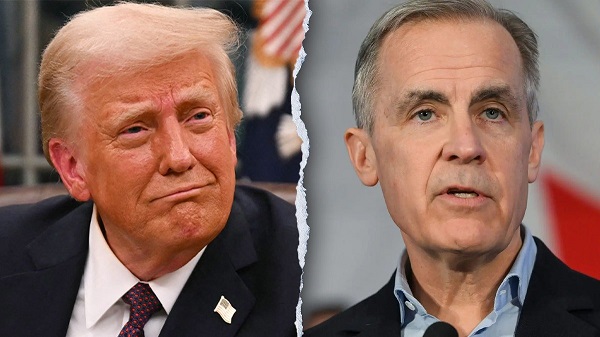Economy
CANADA MUST REVIVE A “PIPELINE WEST” – Indigenous Ownership and Investment in Energy Projects are Critical to Canada’s Oil Customer Diversification

From EnergyNow.Ca
Interesting events renewed discussions around pipeline projects when Alberta Premier, Daniel Smith made social media comments on Jan 21.2025 that Canada should have more nation-building projects and revive Northern Gateway.
It inspired an immediate comment from the President of the Union of BC Indian Chiefs, Grand Chief Stewart Phillip expressing interest in reviving the project. “If we don’t build that kind of infrastructure, Trump will,” Phillip said. “And there won’t be any consideration for the environment, for the rule of law… I think we can do better.”
The next day, Chief Phillip retracted the comment leaving questions about the 180-degree pivot.
Some proponents of Indigenous development, like Calvin Helin, a member of the Tsimshian Nation and Principal at INDsight Advisers, a lawyer who specializes in commercial and Indigenous law and best-selling author, thought the event raised questions about influence.
“Environmental groups have infiltrated some Indigenous organizations,” Helin said in an interview. “They managed to support a government that championed their agendas, particularly agendas involving Alberta – objectives like the coastal pipeline ban and changes to the regulatory approval system. In this era of Trump, all they’ve managed to do is to weaken Canada’s position.”
Helin stressed that in 2025, the energy industry clearly understands the mandate to deal seriously with Indigenous interests, with Indigenous leaders coming forward to support natural resource development while respecting the environment. He suggested that Indigenous inclusion and recognition at the outset is essential for energy projects in 2025 and beyond.
Back in 2018-2019, Helin proposed the Eagle Spirit Corridor a $50 -billion First Nations majority-owned Canadian four pipeline corridor after the Northern Gateway Pipeline was under consideration.
Helin had consulted early with Indigenous groups and proposed a robust natural resource corridor from Bruderheim, AB to Grassy Point, BC. The project involved the support of 32 First Nations from the outset. A variety of shared services were proposed to make the corridor more economical than a pipeline. Helin expected the project would create tens of thousands of jobs over the long term, as well as generate tax revenue and royalties, but it was killed by the federal government’s Bill C-48 tanker ban which stopped companies from using terminals along BC’s north coast to ship oil. The project was ultimately abandoned.
The Enbridge Northern Gateway Pipeline project for a twin pipeline from Bruderheim, AB, to Kitimat, BC, was also stopped by Bill C-48. Both Eagle Spirit and Northern Gateway chose the north BC coast for transportation to Asian markets for the deeper waters that could accommodate larger-capacity crude oil tankers.
The routes of the Eagle Spirit and Northern Gateway pipelines/corridors are quite similar with Eagle Spirit’s route extending a bit farther north in the final leg, as in the maps below.


Recent threats of tariffs on Canadian imports made by U.S. President Trump have stimulated calls to revive pipeline projects to tidewater, including Northern Gateway.
In direct reference to Northern Gateway, Enbridge CEO Greg Ebel has stated to media that Canada would have to designate major pipeline projects as legally required “in the national interest” before companies will consider investing again.
After the cancellation of Northern Gateway, Dale Swampy,the Indigenous leader who helped to establish the Northern Gateway Aboriginal Equity Partners group (AEP), formed the National Coalition of Chiefs(NCC), a group of pro-development First Nation Chiefs who advocate for the development of oil and gas resources in their communities.
Dale Swampy, President of the NCC says it still makes good sense to get a pipeline devoted to bitumen to the West Coast and that Canada has been “putting all its eggs in one basket” for 50 years and has been selling to just one customer while “everybody else in the oil industry, including the U.S., is getting into the global competitive market.”
The Canadian Energy Centre reports that the oil and gas industry is not going into decline over the next decade and in fact, the demand for oil and gas in emerging and developing economies will remain robust through 2050. In light of the multiple effects of U.S. tariffs, Canadian pipelines to tidewater are seen as urgent. Swampy advocates for policy change and the revival of the Northern Gateway project powered by Indigenous equity investment.
“First, we have got to get rid of the oil tanker ban (C-48),” Swampy said. “We’ve got to get more fluid regulatory processes so that we can get projects built in a reasonable timeline so that it doesn’t cost us billions more, waiting for the regular regulatory process to be complete- like TMX. You’ve also got to get the proponents back to the table. We had 31 of the 40 communities already signed on last time. I believe that we can get them signed on again.”
He continues to work with industry to develop an Indigenous-led bitumen pipeline project to the west coast. “We can get this project built if it’s led by First Nations.”
He says other Indigenous leaders are starting to realize the benefits of cooperating with natural resource development, whether it’s mining or the BC LNG projects that he says are now more widely accepted by First Nations.
Stephen Buffalo, President and CEO of the Indian Resource Council of Canada (IRC) agrees.
“I talk about ripple effects,” Buffalo said. “When Jason Kenney was Premier of Alberta, and the Trans Mountain expansion was a big discussion, he wanted to ensure that First Nations had an opportunity to be some sort of equity owner in projects. With the lack of investment capital, he created the Alberta Indigenous Opportunities Corporation with the province as a government backstop.”
Buffalo says the IRC has assembled just over $800 million in government backstop for First Nations to participate in projects which found strong proponents. And those projects are related to natural resource development. He acknowledged that some communities – some of them in BC, don’t see the big picture of what Indigenous Opportunities Corporations can allow them to do.
“You shouldn’t get in the way of others that really need access to healthcare and education and want to develop their communities. I always tell people, our land base, that we were given under the Indian Act, isn’t changing what our populations are. We need housing, and we need the infrastructure, which includes clean water.”
He sees the urgent need for First Nations to get out of poverty and alliances to develop natural resources are key.
“ When we landlock our resources, the U.S. economy seems to get better. Now we’re dependent on the U.S. We have to send our oil to the U.S. at a huge discount. Could or should we have Northern Gateway? Absolutely. Should we have Energy East? Absolutely. We’re importing oil, but we have it at home. Why do we need to import it?”
Buffalo agreed that project discussions and regulations have huge value, but the slowness of the discussion, including pushback from environmental groups that influence discussions is negatively impacting First Nation development. In the case of regulations like Bill C-59, the anti-greenwashing bill, Buffalo says it has silenced many of the members of the Indian Resource Council.
“I’m just looking after our communities,” Buffalo says, “the ones that are never written about, talked about, the ones that don’t have clean water, that don’t have adequate housing, that are lacking education foundations, that are lacking good health care. When government regulatory bodies are making decisions, they’re making decisions for those people that they don’t ever see or ever talk to.”
My discussions with Calvin Helin, Stephen Buffalo and Dale Swampy resulted in a few policy suggestions for 2025 and beyond.
- Repeal Bill C- 69 – It not only blocks all pipelines but stops mines, refineries, export plants and other energy infrastructure that First Nations want to invest in. C-69 is unconstitutional- as ruled on October 13.2023 by Canada’s top court.
- Cut Taxes in Response to U.S. Tariffs– Tax cuts on investment and energy can neutralize the cost of the tariffs with lower taxes and incentivize investment in Canadian projects. Eliminate the Carbon Tax- Carbon tax elimination has been popular with First Nation leaders who have stated the tax has put us at a strategic disadvantage to other countries.
- Repeal Bill C-59, the anti-green-washing bill, which according to Stephen Buffalo has silenced many of the members of the Indian Resource Council and Bill C-48 – the Tanker Ban.
- Greenlight LNG Plants and related infrastructure– Canada sells gas exports uniquely to the U.S. There is a strong business case for sales to Asian and European markets. In a recent Canadian Energy Ventures webcast it was revealed that Natural Gas is sold as LNG to Europe at 16X the price Canada sells its gas to the U.S. First Nations are successfully involved in Woodfibre LNG, Cedar LNG and Ksi Lisims LNG in BC.
- Cut Regulatory Delay & Speed Up Approvals – Delay undermines investor confidence that projects can be completed in reasonable timelines.
- Reconciliation– Issue clear guidelines on what constitutes meaningful consultation. Industry can treat Indigenous peoples as partners and continue to advance economic reconciliation, including equity partnerships.
Maureen McCall is an energy professional who writes on issues affecting the energy industry.
2025 Federal Election
ASK YOURSELF! – Can Canada Endure, or Afford the Economic Stagnation of Carney’s Costly Climate Vision?

From Energy Now
By Tammy Nemeth and Ron Wallace
Carney’s Costly Climate Vision Risks Another “Lost Liberal Decade”
A carbon border tax isn’t the simple offset it’s made out to be—it’s a complex regulatory quagmire poised to reshape Canada’s economy and trade. In its final days, the Trudeau government made commitments to mandate climate disclosures, preserve carbon taxes (both consumer and industrial) and advance a Carbon Border Adjustment Mechanism (CBAM). Newly minted Prime Minister Mark Carney, the godfather of climate finance, has embraced and pledged to accelerate these commitments, particularly the CBAM. Marketed as a strategic shift to bolster trade with the European Union (EU) and reduce reliance on the U.S., a CBAM appears straightforward: pay a domestic carbon price, or face an EU import fee. But the reality is far more extensive and invasive. Beyond the carbon tariffs, it demands rigorous emissions accounting, third-party verification and a crushing compliance burden.
Although it has been little debated, Carney’s proposed climate plan would transform and further undermine Canadian businesses and the economy. Contrary to Carney’s remarks in mid-March, the only jurisdiction that has implemented a CBAM is the EU, with implementation not set until 2026. Meanwhile, the UK plans to implement a CBAM for 1 January 2027. In spite of Carney’s assertion that such a mechanism will be needed for trade with emerging Asian markets, the only Asian country that has released a possible plan for a CBAM is Taiwan. Thus, a Canadian CBAM would only align Canada with the EU and possibly the UK – assuming that those policies are implemented in face of the Trump Administrations’ turbulent tariff policies.
With the first phase of the EU’s CBAM, exporters of cement, iron and steel, aluminum, fertiliser, electricity and hydrogen must have paid a domestic carbon tax or the EU will charge more for those imports. But it’s much more than that. Even if exporting companies have a domestic carbon tax, they will still have to monitor, account for, and verify their CO2 emissions to certify the price they have paid domestically in order to trade with the EU. The purported goal is to reduce so-called “carbon leakage” which makes imports from emission-intensive sectors more costly in favour of products with fewer emissions. Hence, the EU’s CBAM is effectively a CO2 emissions importation tariff equivalent to what would be paid by companies if the products were produced under the EU’s carbon pricing rules under their Emissions Trading System (ETS).
While that may sound simple enough, in practice the EU’s CBAM represents a significant expansion of government involvement with a new layer of bureaucracy. The EU system will require corporate emissions accounting of the direct and indirect emissions of production processes to calculate the embedded emissions. This type of emissions accounting is a central component of climate disclosures like those released by the Canadian Sustainability Standards Board.
Hence, the CBAM isn’t just a tariff: It’s a system for continuous emissions monitoring and verification. Unlike traditional tariffs tied to product value, the CBAM requires companies exporting to the EU to track embedded emissions and submit verified data to secure an EU-accredited verification. Piling complexity atop cost, importers must then file a CBAM declaration, reviewed and certified by an EU regulatory body, before obtaining an import certificate.
This system offers little discernible benefit for the environment. The CBAM ignores broader environmental regulatory efforts, fixating solely on taxation of embedded emissions. For Canadian exporters, Carney’s plan would impose an expensive, intricate web of compliance monitoring, verification and fees accompanied by uncertain administrative penalties.
Hence, any serious pivot to the EU to offset trade restrictions in the U.S. will require a transformation of Canada’s economy, one with a questionable return on investment. Carney’s plan to diversify and accelerate trade with the EU, whose economies are increasingly shackled with burdensome climate-related policies, ignores the potential of successful trade negotiations with the U.S., India or emerging Asian countries. The U.S., our largest and most significant trading partner, has abandoned the Paris Climate Agreement, ceased defence of its climate-disclosure rule and will undoubtedly be seeking fewer, not more, climate-related tariffs. Meanwhile, despite rulings from the Supreme Court of Canada, Carney has doubled down on his support for the Trudeau governments’ Impact Assessment Act (Bill C-69) and confirmed intentions to proceed with an emissions cap on oil and gas production. Carney’s continuance of the Trudeau governments’ regulatory agenda combined with new, proposed trade policies will take Canada in directions not conducive to future economic growth or to furthering trade agreements with the U.S.
Canadians need to carefully consider whether or not Canada can endure, or afford, Carney’s costly climate vision that risks another “lost Liberal decade” of economic stagnation?
Tammy Nemeth is a U.K.-based strategic energy analyst.
Ron Wallace is an executive fellow of the Canadian Global Affairs Institute and the Canada West Foundation.
Business
Closing information gaps to strengthen Canada’s border security and track fentanyl

By Sean Parker, Dawn Jutla, and Peter Copeland for Inside Policy
To promote better results, we lay out a collaborative approach
Despite exaggerated claims about how much fentanyl is trafficked across the border from Canada to the United States, the reality is that our detection, search, and seizure capacity is extremely limited.
We’re dealing with a “known unknown”: a risk we’re aware of, but don’t yet have the capacity to understand its extent.
What’s more, it may be that the flow of precursor chemicals—ingredients used in the production of fentanyl—is where much of the concern lies. Until we enhance our tracking, search, and seizure capacity, much will remain speculative.
As border security is further scrutinized, and the extent of fentanyl production and trafficking gets brought into sharper focus, the role of the federal government’s Precursor Chemical Risk Management Unit (PCRMU)—announced recently by Health Canada—will become apparent.
Ottawa recently took action to enhance the capabilities of the PCRMU. It says the new unit will “provide better insights into precursor chemicals, distribution channels, and enhanced monitoring and surveillance to enable timely law enforcement action.” The big question is, how will the PCRMU track the precursor drugs entering into Canada that are used to produce fentanyl?
Key players in the import-export ecosystem do not have the right regulatory framework and responsibilities to track and share information, detect suspect activities, and be incentivized to act on it. That’s one of the reasons why we know so little about how much fentanyl is produced and trafficked.
Without proper collaboration with industry, law enforcement, and financial institutions, these tracking efforts are doomed to fail. To promote better results, we lay out a collaborative approach that distributes responsibilities and retools incentives. These measures would enhance information collection capabilities, incentivize system actors to compliance, and better equip law enforcement and border security services for the safety of Canadians.
Trade-off bottleneck: addressing the costs of enhanced screening
To date, it’s been challenging to increase our ability to detect, search, and seize illegal goods trafficked through ports and border crossings. This is due to trade-offs between heightened manual search and seizure efforts at ports of entry, and the economic impacts of these efforts.
In 2024, the Canada Border Services Agency (CBSA) admitted over 93 million travelers. Meanwhile, 5.3 million trucks transported commercial goods into Canada, around 3.6 million shipments arrived via air cargo, nearly 2 million containers were processed at Canadian ports, roughly 1.9 million rail cars carried goods into the country, and about 145.7 million courier shipments crossed the border. The CBSA employs a risk-based approach to border security, utilizing intelligence, behavioral analysis, and random selection to identify individuals or shipments that may warrant additional scrutiny. This triaging process aims to balance effective enforcement with the facilitation of legitimate travel and trade.
Exact percentages of travelers subjected to secondary inspections are not publicly disclosed, but it’s understood that only a small fraction undergo such scrutiny. We don’t learn about the prevalence of these issues through our border screening measures, but in crime reporting data—after it’s too late to avert.
It’s key to have an approach that minimizes time and personnel resources deployed at points of entry. To be effective without being economically disruptive, policymakers, law enforcement, and border security need to strengthen requirements for information gathering, live tracking, and sharing. Legislative and regulatory change to require additional information of buyers and sellers—along with stringent penalties to enforce non-compliance—is a low-cost, logistically efficient way of distributing responsibility for this complex and multifaceted issue. A key concept explored in this paper is strengthening governance controls (“controls”) over fentanyl supply chains through new processes and data digitization, which could aid the PCRMU in their strategic objectives.
Enhanced supply chain controls are needed
When it comes to detailed supply chain knowledge of fentanyl precursor chemicals moving in and out of Canada, regulator knowledge is limited.
That’s why regulatory reform is the backbone of change. It’s necessary to ensure that strategic objectives are met by all accountable stakeholders to protect the supply chain and identify issues. To rectify the issues, solutions can be taken by the PCRMU to obtain and govern a modern fentanyl traceability system/platform (“platform”) that would provide live transparency to regulators.
A fresh set of supply chain controls, integrated into a platform as shown in Fig. 1, could significantly aid the PCRMU in identifying suspicious activities and prioritizing investigations.

Our described system has two distinctive streams: one which leverages a combination of physical controls such as package tampering and altered documentation against a second stream that looks at payment counterparties. Customs agencies, transporters, receivers, and financial institutions would have a hand in ensuring that controls in the platform are working. The platform includes several embedded controls to enhance supply chain oversight. It uses commercially available Vision AI to assess packaging and blockchain cryptography to verify shipment documentation integrity. Shipment weight and quantity are tracked from source to destination to detect diversion, while a four-eyes verification process ensures independent reconciliation by the seller, customs, and receiver. Additionally, payment details are linked to shipments to uncover suspicious financial activity and support investigations by financial institutions and regulators like FINTRAC and FINCEN.
A modern platform securely distributes responsibility in a way that’s cost effective and efficient so as not to overburden any one actor. It also ensures that companies of all sizes can participate, and protects them from exploitation by criminals and reputational damage.
In addition to these technological enhancements and more robust system controls, better collaboration between the key players in the fentanyl supply chain is needed, along with policy changes to incentivize each key fentanyl supply chain stakeholder to adopt the new controls.
Canadian financial institutions: a chance for further scrutiny
Financial institutions (FIs) are usually the first point of contact when a payment is being made by a purchaser to a supplier for precursor chemicals that could be used in the production of fentanyl. It is crucial that they enhance their screening and security processes.
Chemicals may be purchased by wires or via import letters of credit. The latter is the more likely of the two instruments to be used because this ensures that the terms and conditions in the letter of credit are met with proof of shipment prior to payment being released. Payments via wire require less transparency.
Where a buyer pays for precursor chemicals with a wire, it should result in further scrutiny by the financial institution. Requests for supporting documentation including terms and conditions, along with proof of shipment and receipt, should be provided. Under new regulatory policy, buyers would be required to place such supporting documentation on the shared platform.
The less transparent a payment channel is in relation to the supply chain, the more concerning it should be from a risk point of view. Certain payment channels may be leveraged to further mask illicit activity throughout the supply chain. At the onset of the relationship the seller and buyers would link payment information on the platform (payment channel, recipient name, recipient’s bank, date, and payment amount) to each precursor or fentanyl shipment. The supplier, in turn, should record match payment information (payment channel, supplier name, supplier’s bank, date, and payment amount).
Linking payment to physical shipment would enable data analytics to detect irregularities. An irregularity is flagged when the amounts and/or volume of payments far exceed the value of the received goods or vice versa. The system would be able to understand which fentanyl supply chains tend to use a particular set of FIs. This makes it possible to conduct real-time mapping of companies, their fentanyl and precursor shipments and receipts, and the payment institutions they use. With this bigger picture, FIs and law enforcement could connect the dots faster.
Live traceability reporting
Today, suppliers of fentanyl precursors are subject to the Pre-Export Notification Online (PEN Online) database. This database enables governments to monitor international trade in precursor chemicals by sending and receiving pre-export notifications. The system helps prevent the diversion of chemicals used in the illicit manufacture of drugs by allowing authorities to verify the legitimacy of shipments before they occur.
To further strengthen oversight, the platform utilizes immutability technologies—such as blockchain or secure immutable databases—which can be employed to encrypt all shipping documents and securely share them. This presents an auditable form of chain-of-custody and makes any alterations apparent. Customs and buyers would have the capability to verify the authenticity of the originating documents in a way that doesn’t compromise business confidentiality. With the use of these technologies, law enforcement can narrow down their investigations.
An information gap currently exists as the receivers of the shipments don’t share their receipts information with PEN. To strengthen governance on fentanyl supply chains, regulatory policy and legislative changes are needed. The private sector should be mandated to report received quantities of fentanyl or its precursors, as well as suspicious receiving destinations. This could be accomplished on the platform which would embed the receiving process, a reconciliation process of the transaction, the secure upload and sharing of documents, and would be minimally disruptive to business processes.
Additionally, geo-location technology embedded in mobile devices and/or shipments would provide real-time location-based tracking of custody transactions. These geo-controls would ensure accountability across the fentanyl supply chain, in particular where shipments veer off or stop too long on regular shipping routes. Canadian transporters of fentanyl and its precursor chemicals should play an important role in detecting illicit diversion/activities.
Digital labelling
Licensed fentanyl manufacturers could add new unique digital labels to their shipments to get expedited clearance. For example, immutable digital labelling platforms enable tamper-proof digital labels for legitimate fentanyl shipments. This would give pharmacies, doctors, and regulators transparency into the fentanyl’s:
- Chemical composition and concentrations (determining legitimate vs. adulterated versions of the drug)
- Manufacturing facility ID, batch ID, and regulatory compliance status
- Intended buyer authentication (such as licensed pharmaceutical firms or distributors)
Immutable digital labelling platforms offer secure role-based access control. They can display customized data views according to time of day, language, and location. Digital labels could enable international border agencies and law enforcement to receive usable data, allowing legal shipments through faster while triggering closer shipment examinations for those without of a digital label.
International and domestic transporter controls
Transporters act as intermediaries in the supply chain. Their operations could be monitored through a regulatory policy that mandates their participation in the platform for fentanyl and precursor shipments. The platform would support a mobile app interface for participants on-the-move, as well as a web portal and application programming interfaces (APIs) for large-size supply chain participants. Secure scanning of packaging at multiple checkpoints, combined with real-time tracking, would provide an additional layer of protection against fraud, truckers taking bribes, and unauthorized alterations to shipments and documents.
Regulators and law enforcement participation
Technology-based fentanyl controls for suppliers, buyers, and transporters may be reinforced by international customs and law enforcement collaboration on the platform. Both CBSA and law enforcement could log in and view alerts about suspicious activities issued from the FIs, transporters, or receivers. The reporting would allow government personnel to view a breakdown of fentanyl importers, the number of import permit applications, and the amount of fentanyl and its precursors flowing into the country. Responsible regulatory agencies—such as the CBSA and PCRMU—could leverage the reporting to identify hot spots.
The platform would use machine learning to support CBSA personnel in processing an incoming fentanyl or precursor shipment. Machine learning refers to AI algorithms and systems that improve their knowledge with experience. For example, an AI assistant on the traceability system could use machine learning to predict and communicate which import shipments arriving at the border should be passed. It can base these suggestions on criteria like volume, price, origin of raw materials, and origin of material at import point. It can also leverage data from other sources such as buyers, sellers, and banks to make predictions. As an outcome, the shipment may be recommended to pass, flagged as suspicious, or deemed to require an investigation by CBSA.
It’s necessary to keep up to date on new precursor chemicals as the drug is reformulated. Here, Health Canada can play a role, using its new labs and tests—expected as part of the recently announced Canadian Drug Analysis Centre—to provide chemical analysis of seized fentanyl. This would inform which additional chemical supply chains should be tracked in the PCRMU’s collaborative platform, and all stakeholders would widen their scope of review.
These new tools would complement existing cross-border initiatives, including joint U.S.-Canada and U.S.-Mexico crackdowns on illicit drug labs, as well as sovereign efforts. They have the potential to play a vital role in addressing fentanyl trafficking.
A robust, multi-pronged strategy—integrating existing safeguards with a new PCRMU traceability platform—could significantly disrupt the illegal production and distribution of fentanyl. By tracking critical supply chain events and authenticating shipment data, the platform would equip law enforcement and border agencies in Canada, the U.S., and Mexico with timely, actionable intelligence. The human toll demands urgency: from 2017 to 2022, the U.S. averaged 80,000 opioid-related deaths annually, while Canada saw roughly 5,500 per year from 2016 to 2024. In just the first nine months of 2024, Canadian emergency services responded to 28,813 opioid-related overdoses.
Combating this crisis requires more than enforcement. It demands enforceable transparency. Strengthened governance—powered by advanced traceability technology and coordinated public-private collaboration—is essential. This paper outlines key digital controls that can be implemented by global suppliers, Canadian buyers, transporters, customs, and financial institutions. With federal leadership, Canada can spearhead the adoption of proven, homegrown technologies to secure fentanyl supply chains and save lives.
Sean Parker is a compliance leader with well over a decade of experience in financial crime compliance, and a contributor to the Macdonald-Laurier Institute.
Dawn Jutla is the CEO of Peer Ledger, the maker of a traceability platform that embeds new control processes on supply chains, and a professor at the Sobey School of Business.
Peter Copeland is deputy director of domestic policy at the Macdonald-Laurier Institute.
-

 2025 Federal Election1 day ago
2025 Federal Election1 day agoPPE Videos, CCP Letters Reveal Pandemic Coordination with Liberal Riding Boss and Former JCCC Leader—While Carney Denies Significant Meeting In Campaign
-

 Health2 days ago
Health2 days agoExpert Medical Record Reviews Of The Two Girls In Texas Who Purportedly Died of Measles
-

 2025 Federal Election2 days ago
2025 Federal Election2 days agoTrudeau and Carney Have Blown $43B on EVs
-

 2025 Federal Election1 day ago
2025 Federal Election1 day agoNo Matter The Winner – My Canada Is Gone
-

 2025 Federal Election21 hours ago
2025 Federal Election21 hours agoCSIS Warned Beijing Would Brand Conservatives as Trumpian. Now Carney’s Campaign Is Doing It.
-

 2025 Federal Election17 hours ago
2025 Federal Election17 hours agoInside Buttongate: How the Liberal Swamp Tried to Smear the Conservative Movement — and Got Exposed
-

 2025 Federal Election2 days ago
2025 Federal Election2 days agoMark Carney Vows Internet Speech Crackdown if Elected
-

 Alberta24 hours ago
Alberta24 hours agoProvince to expand services provided by Alberta Sheriffs: New policing option for municipalities









